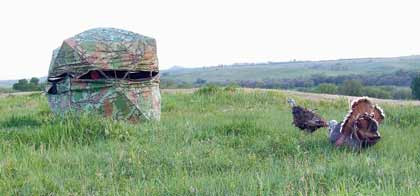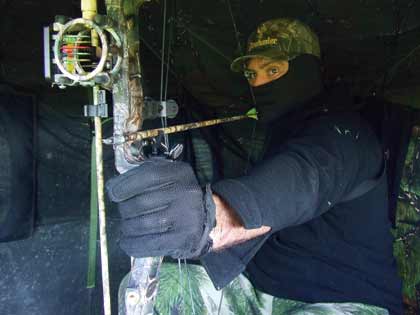March 29, 2011
By C.J. Winand
When the guide says to sight-in for five yards, you can expect the hunting to get intense.
By C.J. Winand

Advertisement
On the plains of South Dakota, full-concealment ground blinds and realistic decoys form a deadly combination. |
Advertisement
Over the years, I've collected so many unused spring turkey tags I could fill a book with them. While turkeys may be easy in some areas, the competition where I live in Maryland is intense and the turkeys are smart. Still, I'm stubborn enough never to have given up on my goal of taking a turkey with my bow.
To accelerate my quest, I called two turkey masters, Keith Beam and Brooks Johnson of Double Bull Archery. After my call for help, they directed me to Dave Keiser, owner of Double K Guide Service in Gregory, South Dakota, and right away I contacted Dave.
"We put a lot of work into locating our birds and simply want our hunters to be successful. I suggest you sight-in for five yards," Dave said. "Too many times, the birds will come right into our decoys, and those close shots can be the toughest!"
As we continued to talk turkeys, Dave's passion was obvious. He said we would be hunting primarily Merriam turkeys, but that his area also has Eastern/Merriam hybrids.


READ: Tips For Recovering Your Longbeard


To add further appeal, he said that, due to lack of predators, turkey numbers were high right now. "Two years ago, mange swept the area and wiped out the coyotes. As a result, our properties are full of turkeys -- including lots of longbeards."
This sounded like just the hunt I needed to break my turkey jinx.
However, it did not prove to be an instant fix. During this, the last week of South Dakota's spring season, all the toms seemed to be paired up with hens, and despite our best calling efforts, they continually remained just outside of my effective range. The first two days of the hunt could be summarized much like all my years of hunting Eastern turkeys -- so close...


READ: The Gobbler Guru Of Gregory, South Dakota


Still, they were valuable because I was learning a lot about turkey hunting. Keith and Brooks use mounted turkeys for decoys, and these imitations, made by Angie Wilson of Wild Intrigue Taxidermy, fool the wariest toms. While Angie uses a turkey skin on the body of each decoy, she attaches a plastic head from a taxidermist's supply catalog. Two metal pins spike the decoy to the ground, making it almost impossible to dislodge. In the wind, the decoy's feathers flutter like the feathers on a live bird. So realistic are Angie's creations that Keith and Brooks have taken numerous gobblers trying to breed them, and even after looking at them all morning, I psyched myself out on several occasions and almost drew my bow on them. Even after daily use for a full season, the decoys remained in good shape.
Recently, Keith and Brooks have begun attaching a monofilament line to the plastic head of each decoy to create a bobble-head motion. Although I thought this technique would be cumbersome to work from the blind, it was not. Many of Keiser's hunters reported good success with this technique. When gobblers hung up out of range, the bobble-head effect pulled them right on in.
The Double Bull boys regularly place either a hen or jake decoy no more than 10 yards from the blind. "Even if a tom hangs up outside the decoys, he'll be within good range if you keep the decoys close," Brooks said. "And if a bird approaches from behind the blind, he'll most likely turn to strut and give you a perfect broadside shot -- very close."

To blend with the black interior of my blind, I wore a black shirt, face mask, and gloves. The roomy Double Bull blind gave me plenty of space to maneuver and draw my bow. |
The Double Bull guys also use what they call the "turkey rug," the back skin and tail feathers of a turkey laid flat on the ground, with the tail feathers propped up with a clothes hanger. Keith believes this item makes dominant toms or call-shy birds want to pounce on subordinate toms. On more than one occasion, Keith and Brooks have shot toms as they mount and peck the dickens out of a turkey rug.
"At first I thought the turkey rug was a little farfetched," Keith said. "But our results make us think these turkey rugs will be the next big advance in decoying turkeys. I think it's simply a testosterone thing. When we pair a turkey rug with one of Angie's real-life decoys, it's a win-win scenario."
Keiser has scouting for turkeys down to a science, and each night we would call him to get his advice on where toms might be roosting. After hunting for two days straight without drawing my bow, I was m
ore than ready to cover up a tom with my five-yard pin. That night, he informed us he'd roosted a tom his hunters had been after all season. "That gobbler has been call-shy all season, but if you set up your blind in the dark, you should be able to decoy him into range," Keiser said.
By 5 a.m., my cameraman and I had our Double Bull blind set up with two of Angie's decoys 10 yards out front. With camera and bow at the ready, we watched the silhouettes of turkeys roosted in a dead cottonwood tree materialize in front of the emerging sun. With the growing light, the birds began to shuffle, and suddenly the big tom flew down directly in front of us. Then two jakes flew in from the left while four hens followed right behind them. After two days of calling, we now had seven turkeys directly in front of our blind -- and we hadn't made a sound.
Keiser had told us this was the dominant tom in the area, and we determined that he was right as all the other birds stayed a good 15 yards away while he postured in front of us. The boss gobbler's full attention was now directed on our decoys, and as he came to full strut, he slowly eased over to Angie's hen decoy.
At this point, I was entering my "turkey zone," in which the whole world is nonexistent except the gobbler. As he came within 11 yards and filled my top sight pin, I let the arrow fly. As it broke both wing bones, the tom hit the ground.
The three-year-old bird weighed 191„2 pounds and had a 9-inch beard and 11„8-inch-long spurs. After years of unsuccessful bowhunts for turkeys, I now had my bird. Thinking of the thousands of times I had called to turkeys, I find it ironic that I hadn't made the slightest sound to arrow my first gobbler. Over the years, I've collected so many unused turkey tags I could fill a book with them. Finally, I've started a new chapter.
You can buy spring turkey permits in South Dakota over the Internet. For one of the best turkey hunting operations in the country, contact: Dave Keiser, Double K Guide Service, To order realistic feathered turkey decoys, contact: Angie Wilson, Wild Intrigue Taxidermy.

